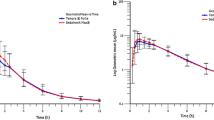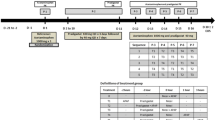Summary
Acetaminophen is a common antipyretic-analgesic drug usually administered orally any time of the day. It was however claimed by Belanger et al, (1985) to have a longer elimination half-life (t1/2β) in rats when administered by 2100 h, than at 0700 h. This work is designed to investigate this claim in man and to study the circadian changes in acetaminophen pharmacokinetics at three dosing times; 0730 h, 1300 h and 2100 h. Seven healthy male volunteers, age 26.28±3.01 years, weighing 65.00±2.2 kg, were administered with 1000 mg oral acetaminophen at the three circadian time after a period of fast of not less than 4 h. The pharmacokinetic values obtained, though varied, are found to be in similar ranges with previously reported values. The absorption parameters ka and mean Tmax were significantly altered with dosing at 0730 h and 2100 h while the mean t1/2α and ka were also significantly changed. There was a significant difference (P<0.05) between the Tmax values obtained at 2100 h and that of 0730 h, while the 34.9% increase at dosing time 1300 h over 0730 h dosing times is not statistically significant (P>0.05). Cmax was found to be 22.31±4.24 mcg/ml for 0730h dosing time, while a decrease of 9.64 and 11.7% over this value was recorded for dosing time 1300 h and 2100 h respectively. The changes are however not statistically significant (P>0.05). AUCo−a at 0730 h did not show any significant change when compared with values obtained at 1300 h and 2100 h, but there was a significant difference between the values obtained at 1300 h and 2100 h. Elimination half-life, t1/2β was found to be 1.68±0.67 h at 0730 h. There was an increase of 13.1% and 20.83% over this value at 1300 h and 2100 h. These increases were not statistically significant (p>0.05). Although there are similar increases in t1/2β at the 1300 h and 2100 h dosing time as reported by Belanger et al 1985, the increases were not statistically significant in man.
Similar content being viewed by others
References
Shamba E and Adotey J. (1982)._-http://www.uz.ac.zw/medicine/ pharmacy/pubs/1982.html.
The Pharmaceutical Codex (1979): 11th Ed. 1979, The Pharmaceutical Press, 1 Lambeth High Street, London SEI JN USA.
Bruguerolle B. (1998): Chronopharmacokinetics. Current Status. [Review]. Clin. Pharmacokinet. 35(4); 83–94.
Markiewicz A. and Semenowicz K. (1979): Circadian changes in intestinal absorption. Chronobiologia (Milan), 6, 129.
Valli-M, Bruguerolle B, Bouyard L, Jadot G. and Bouyard P. (1980): Pharmacokinetics of Carbamazepine in fasted and fed rats. J. Pharmacol 11, 201.
Kabasakalian P. Katz M., Rosenkrantz and Towley E (1970): ‘Chronokinetics of griseofulvin after a high-fat meal in human volunteers at breakfast and at dinner’. J. Pharm Sci. 59, 595.
Brugueroll B, Levi F, Arnaud C, Bouvenot G, Mechkouri M, Vennetzel J. M. and Touitou T. (1986): Annu. Rev. Chronopharmacol. 3, 207.
Naranjo C. A. Seller E. M. Giles H. G. and Abel J. G. B. (1980): ‘Diurnal changes of diazepam concentration in the serum’. Br. J. Clin. Pharmacol. 9, 265.
Patel I. H. Venkatavannan R., Levy R. H., Viswanathorn R. H and Ojemann L M. (1982): ‘Plasma protein characteristics of valprotic acid in humans’. Epilepsia (NY) 23, 282.
Radzialower G. and Bonsquet, W. F. (1968): Aminopyrine metabolism — enzyme activity in the day and night. J. Pharmacol Exp Ther. 163, 229.
Halberg F, Kabat H.F, Klein P. (1980): Am J. Hosp.: Pharm. 37 (Jan), 101–102
Belanger P. M. Lalande M, Labrecque G. and Dore F. (1985): Drug metab. Dispos. 18, 386.
Glynn J.P. and Kandel S. E. (1975): Paracetamol Measurement. Lancet (1); 1147–1158.
Goodman and Gilman’s (1995): The Pharmacological Basis of Therapeutic. 9th Ed. International Ed. Pg. 1–25.
Yiamouyiannis C.A, Harris A. Sanders R. A. Martin B. J. Watkins J.B (1994): Paracetamol pharmacokinetics are independent of caloric intake and physical activity. Drug Invest. 8, 361–368.
Rumble R. H., Rebert M.S., Denton M.J. (1991): Effects of posture and sleep on the pharmacokinetics of acetaminophen and its major metabolites. Clin. Pharmacokinet. 20, (2); 167–173.
Author information
Authors and Affiliations
Rights and permissions
About this article
Cite this article
Kolawole, J.A., Chuhwak, P.D. & Okeniyi, S.O. Chronopharmacokinetics of acetaminophen in healthy human volunteers. Eur. J. Drug Metab. Pharmacokinet. 27, 199–202 (2002). https://doi.org/10.1007/BF03190458
Received:
Issue Date:
DOI: https://doi.org/10.1007/BF03190458




